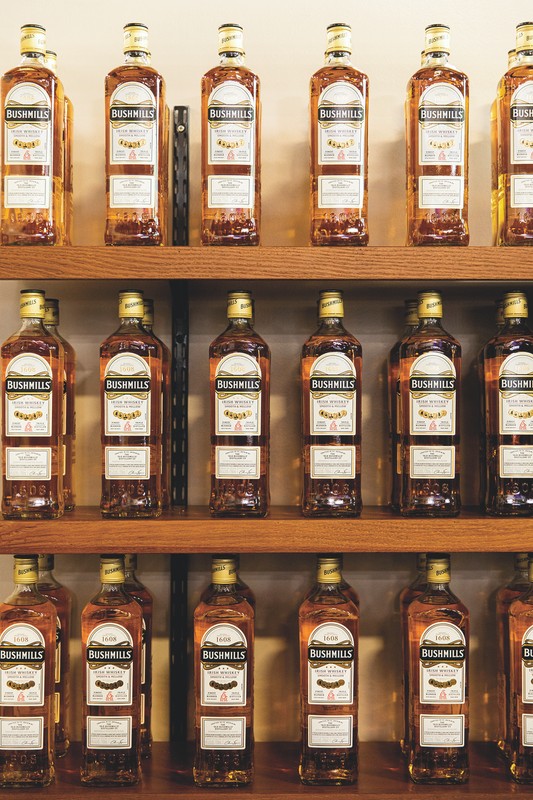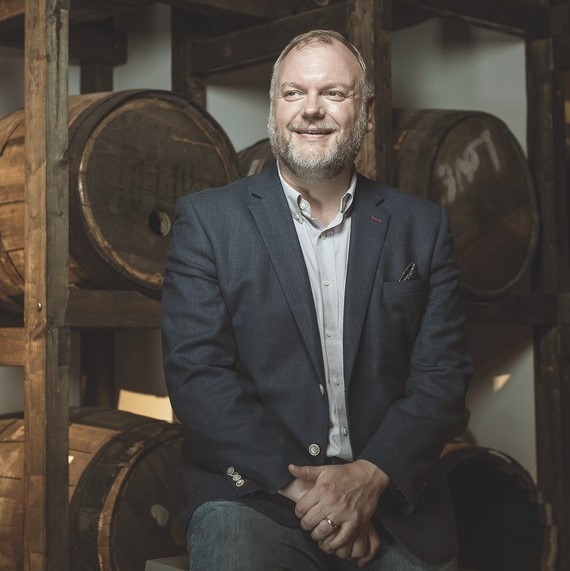
For Irish whiskey in the U.S., 2020 was the most challenging year in over a decade, with the abrupt changes caused by the Covid-19 pandemic damaging the category’s success in the on-premise and forcing an abrupt shift toward retail. Although the overall category slipped 0.5% to just over 4.6 million cases, the majority of leading brands successfully reached consumers in the off-premise and grew. Despite widespread growth, however, the category’s leader—Pernod Ricard’s Jameson—has such a wide lead that the overall market bends to its performance and last year Jameson dropped 3.9% to 3.59 million cases.
While 2020 paused Irish whiskey’s tremendous growth, the category is still very near its all-time high in 2019 of 4.63 million cases. One challenging year could not erase the tremendous gains the category has made in the last half decade: of the eight leading brands that existed in 2015, only two are smaller today than back then. Though the on-premise closures changed how Irish whiskey was sold in the last year and a half, retailers continue to see category interest and substantial sales, especially among Jameson and its off-shoots like Cold Brew.
“Jameson is kind of the huge juggernaut that it is. I think they have 10 SKUs in our top 15 for the category in the stores,” says Jeff Feist, category lead for spirits and more at West Coast retailer BevMo. “With that said, we do see premiumization happening in the Irish category, like we do in a lot of categories. Items like Yellow Spot, Teeling, and Redbreast 12 all continue to really drive a lot of volume for us as a trade-off mechanism.”
Looking even further, Irish whiskey’s growth over the last 15 years is even more astounding. In 2005, Irish whiskies depleted 600,000 cases in the U.S. Since then, the category has ballooned, with Jameson remaining the commanding player. In 2005, Jameson had 61% of the U.S. market share at 360,000 cases. In the last 15 years, that share has grown to 77.7%, even as the overall pie has grown. The remaining brands commanding space in the category have remained largely unchanged: Tullamore D.E.W. and Bushmills are still leading brands, with Proper No. Twelve rising to nearly the top of the heap.

At The Top
Despite challenges overall, Jameson continued to see success with higher end releases like Black Barrel, a trend that has continued in 2021. Throughout the pandemic, consumers flocked to releases like Black Barrel and Jameson Cold Brew, with the company reporting a 30% bump in value for those releases. “Although some consumers may have preconceptions about Irish whiskey—especially when it comes to taste, when to consume, and how to mix in a cocktail—we’re seeing its popularity continue to grow as more consumers understand the versatility and approachability of the category. This interest has accelerated innovation, which is great news for the category as a whole,” says Pernod Ricard USA’s vice president of marketing for Jameson Sona Bajaria.
Overall, Pernod says the recovery has been stronger than expected, with the company profit from recurring operations for its fiscal year ended in June to be up in the range of 16%, up from the previous marker of 10% set down in April. With the on-premise recovery in full swing, it seems likely that 2020 was a speed bump for Jameson that is not indicative of a shift in trends. “Last year, Jameson continued to lead the Irish whiskey category with a 73% share. The core offering of Jameson has been the main driver of this growth, with added momentum from the introduction of Jameson Cold Brew, which was extremely well received,” says Bajaria.

As the owner of Ireland’s Irish Distillers, Pernod Ricard’s portfolio extends well beyond Jameson, especially at the higher-end. The company also owns the fifth largest Irish whiskey in the U.S., Redbreast. Last year, Redbreast jumped 19.1% to 47,000 cases and will almost certainly cross the 50,000 case mark for the first time this year. “2021 has been a very strong year for Redbreast across the range of expressions from 12-year-old to 15, 21, 27, Lustau, & Cask Strength. It remains the largest selling Single Pot Still Irish whiskey in the world with a loyal following and a proud Irish heritage,” says Jeff Agdern, senior vice president at Pernod Ricard USA for the New Brand Ventures & Prestige portfolios.
The brand’s range is made up mostly of age-stated whiskies starting with the 12-year-old that’s matured in Bourbon and Sherry casks, rising to the ultra-limited 27-year-old matured in Sherry, Bourbon, and Port casks, with a Lustau cask-finished whiskey and a cask strength variant offering consumers depth beyond increased age statements. “Redbreast 12, even though it’s a $55 item for us, is the third best selling Irish whiskey that we have,” says Feist. “There’s obviously a clientele for that and it’s found it. We’re really happy with that brand.”
Pernod also releases the Powers range of Irish whiskies, which cover both blends and single pot still releases. Last year, Powers came in as the ninth-largest Irish whiskey in the U.S. at 21,000 cases. The brand struggled last year— dropping 14.7%—though that may be a product of unfortunate timing. In January of last year, Pernod announced a total brand refresh for Powers, planning to roll out a new bottle for its Gold label blended whiskey by Saint Patrick’s Day with the higher-end pot still whiskies Three Swallow and John’s Lane receiving the refresh by mid-year. With the on-premise largely closed during that period, reintroducing consumers to the Powers family became a difficult proposition, especially for a smaller brand.
In March of this year, a deal between Pernod Ricard and spirits industry veterans Elwyn Gladstone and Mark Teasdale was announced that created Lafayette Imports, a wholly owned subsidiary of Gladstone and Teasdale’s existing company Biggar & Leith. This new entity has taken on responsibilities for Powers, plus other small Irish whiskey brands like Knappogue Castle single malts and Clontarf, which Pernod acquired from Castle Brands in 2019.
While Powers has faced some market challenges, it’s still a strong contender in the category. At Texas’ Twin Liquors, it sells well and offers consumers category variety without pushing the price too high. “Right now Irish whiskey has value, quality, and availability,” says director of marketing Sandra Spalding. “Powers is a great example of pot still for a great price. It’s possible that as the Irish whiskey drinker continues their journey they may expand into higher end selections.”

At the peak of the category in a retail price, Pernod Ricard has also released the Spot and Midleton lines. The Spot range includes non-age-statement (NAS) and aged state whiskies, plus wine-cask-finished variants of the NAS Green Spot. The brand’s Yellow Spot is bottled at 12 years and the Red Spot is bottled at 15. The latest release, the Blue Spot, is a 7-year-old cask strength whiskey that returned to the global market late last year after a 56-year absence.
The Midleton whiskies are the luxury arm of Pernod Ricard’s growing pot still empire. The brand releases a vintage blend each year, with the 2021 edition marrying pot still and grain whiskies aged from 13-35 years. Midleton also bottles Barry Crockett Legacy and the Dair Ghaelach line, the latter of which uses Irish oak sourced from forests across the island.
Midleton is truly the luxury pinnacle of Irish whiskey with some releases commanding five-figure prices, Agdern adds, pointing to the Midleton Very Rare’s Silent Distillery collection, which recently launched the second chapter in the collection: a 70-bottle run of 46-year-old whiskey that retails for $45,000.
Agdern notes that Pernod has seen growth for its higher-end offerings but that it is primarily a retail phenomenon so far. “From an on-premise perspective, we haven’t seen re-openings moving the needle in terms of category growth. Much of our growth can be attributed to our innovation pipeline and consumers’ growing interest and enthusiasm for the Irish whiskey category,” he says.

Maintaining Growth
Behind Jameson is William Grant & Sons’ Tullamore D.E.W. The brand was up 1.3% last year to 304,000 cases. Though growth was depressed compared to prior years, Tullamore managed to average a 10% growth rate for the back half of the last decade. The brand leads with a popular blended whiskey and the range extends to a 12-year-old blend, 14-year-old, and 18-year-old single malts, plus a variety of cask-finished whiskies and occasional limited releases. The brand has produced its own single malt and pot still whiskies since 2014 and started up its grain distillery in 2017. Recent production has gone to support the Tullamore’s current portfolio, but late last year master blender Brian Kinsman said that over the next few years Tullamore will start to expand its offerings.
Even though Tullamore D.E.W. has not experienced the exponential growth of Jameson, retailers across the U.S. note that it retains a loyal following, similar to many of the Irish whiskies— Spalding specifically points to Tullamore, Bushmills, and Powers as examples—near the top of the category.
Quickly gaining ground on Tullamore D.E.W. is Proximo Spirits’ Proper No. Twelve, the blended Irish whiskey branded in partnership with MMA fighter Conor McGregor. Last year, the brand led the category in percent growth, up 77% to 232,000 cases, according to Impact Databank. “Since introducing this brand with Conor and his partners just two and a half years ago, Proper No. Twelve has been the most exciting brand in Irish whiskey,” says Proximo CEO Mike Keyes.

Retailers report that the brand continues to sell well, though at a slower clip than in 2020. Twin Liquors’ Spalding pointed to the brand as an interesting one to watch as it spends more and more time on the market. In BevMo’s stores, Proper No. Twelve continues to be a strong seller, but appears to Feist to be tied quite strongly to Conor McGregor’s stardom. “We sold more Proper No. Twelve during the recent UFC fight where Conor McGregor was fighting than for St. Patrick’s Day,” he says. “If you can sell more Irish whiskey in any week, other than the week of St. Patrick’s Day, you’re doing something right.” He adds that Proper No. Twelve 1.75-liter bottles are particularly strong performers in the chain.
The brand’s star is poised to continue to rise and in April of this year, Proximo announced that it was taking a controlling stake in the brand. The long-term deal is worth up to $600 million for brand co-founders McGregor, Audie Attar, and Ken Austin.That sum, according to Austin, includes the $250 million the team already earned in the brand’s first two years in business with Proximo, which previously held a 49% stake.
“When we started this business with Proximo, we laid out certain hurdles that would allow them to buy pieces of the company over time,” says Austin, adding that the brand has now reached approximately 345,000 cases on a trailing 12-month basis. “We hit a milestone and it gave Proximo the opportunity to own a significant stake.” In spring 2020, Proximo raised its stake from 20% to 49%.
According to both Austin and Keyes, the new partnership will not substantially alter how the brand is marketed or its identity, though Austin adds that it would increase their focus on the brand building side of the business as Proximo takes on a larger role in the administrative and financial side.

Bushmills is also in Proximo’s Irish whiskey stable and remains a top ten brand in the U.S., despite sustaining more muted growth than the other major players in the category over the last five years. Last year the brand eked out a 1% gain and hopped over the 200,000 case mark after holding at roughly 195,000 cases over the previous few years. While the brand has struggled to catch fire in the U.S. in recent years, it is still working to gain traction, recently partnering with the Boston Celtics through the 2023 season. The partnership will see the brand create a series of activations and contests tailored to the team alongside custom TV spots.
In addition, Bushmills has kicked off a new line of cask-finished whiskies, though exclusively in the brand’s home market. In April, Bushmills rolled out a new whiskey which blends grain whiskies and rum-cask-finished single malt whiskey. While the release is limited to Ireland, it is the beginning of something new for the brand.
Other Irish brands that have seen steady growth over the last few years are Sazerac’s Paddy and Bacardi’s Teeling. Paddy advanced last year by 12% to 42,000 cases, averaging 8.7% growth from 2015 to 2020. The brand holds its own in the top despite only offering a single release. Bacardi’s Teeling offers a wider portfolio, including single pot still and luxury library releases dating back decades. For 2020, the brand was up 9.8% to 22,000 cases, according to Impact Databank. Teeling offers a Small Batch blended whiskey, plus a single malt, single grain, single pot still, and, as of early this year, a peated single malt called Blackpitts. The distillery also uses a variety of casks to mature its whiskies, and, as of late last year, was experimenting with Port-cask finishing, though a release still quite a ways off.
For Twin Liquors, Spalding notes that Irish whiskey consumers are very brand loyal and that new releases are well received within that framework. “As category Irish is driven by brand loyalty,” she says. “It would do the category well to focus on education of Irish whiskey and how it’s different than Bourbon, Scotch, and Japanese whisky. That will help the entire category grow.”

Underdog Uprising
While the leading Irish whiskey brands and even many of the smaller players are backed by spirits multinationals, an upstart American company is also making moves in the category. Last year, Irish Distillers’ master distiller Brian Nation announced that he was leaving Ireland’s largest distillery to lead operations at O’Shaughnessy Distilling Co., a new craft distillery in Minnesota. Though O’Shaughnessy will be an American whiskey distiller, the company needs to get some liquid on the market while its American spirits mature. Enter Keeper’s Heart.
The brand’s first release will be a blend of Irish grain and pot still whiskies with American rye whiskey sourced from Indiana’s MGP Ingredients and County Louth’s Great Northern Distillery. “I spent the last number of months doing a lot of different blending exercises and developing prototypes for the team to actually taste and understand,” says Nation. “You’ve got that lovely, floral contribution from the grain whiskey coupled with spicy characteristics and fruits from the traditional Irish pot still whiskey. Then you’ve got that additional spice and vibrant fruit from the rye.”
Marketers continue to believe there’s room for growth in the Irish whiskey category, despite the 2020 speed bump, with new brands regularly hitting retail shelves. WhistlePig, known for its high-end rye whiskies, is set to enter the category with Limavady Single Barrel Irish whiskey, a collaboration between the rye company and Darryl McNally, who previously was distillery manager for Bushmills and general manager for Quintessential’s Irish whiskey portfolio.

“Ireland has been producing single malt for at least as long as our neighbors across the channel. The category has since become dominated by blended whiskey, owing to various factors including being monopolized by conglomerates,” says McNally, who will serve as master distiller for the brand. “Going back to single malt, which is both age old and relatively uncommon on the current Irish shelf, is an important part of Limavady’s underdog story.”
Although the brand itself is untested, retailers seem to be taking a keen interest, with BevMo planning to launch the brand as soon as the company can place it on shelves. “We’re actually buying barrels at the launch and we’re going to launch the barrel format before we launch the regular bottle,” says Feist. Initially, he adds, the plan had been to launch private barrels alongside the general single-barrel release, but the retailer decided to go all-in on its own barrels first.
Even as the overall Irish whiskey category suffered a bump due to the challenging conditions of 2020, there is still much excitement and innovation to be found just below the surface. As upstart brands continue to gain market share and legacy offerings crack open unique casks and bottle new, higher-end whiskies, the world of Irish whiskey remains robust and increasingly diverse. “Irish whiskey is one of the fastest-growing spirits categories in the U.S,” says Pernod’s Agdern. “And it’s a category with tremendous versatility that many consumers are starting to better realize as they mix more drinks at home. So as we continue to educate consumers on Irish whiskey’s smooth taste, we also showcase the many ways it can be enjoyed to drive more consumers to retail so they can mix their own drinks.”